Michael Yardney is a prominent property investor/advisor who writes a regular blog on Smart Company. Last week, Mr Yardney posted an article entitled What history can teach us about what’s ahead for property, which is aimed at calming nerves about the Australian housing market and convincing readers that residential housing is still a superior long-term investment option.
It was an intriguing piece to analyse because for once we had a property bull that was prepared to entertain the fact that property prices do sometimes go down. Indeed, Mr Yardley’s argument was that there are property cycles and you need to adjust your expectations to that fact.
Fair enough. But the piece still, sadly, left me cold. Below are key extracts from the article, along with counter-arguments to Mr Yardney’s claims [my emphasis].
I thought that today I’d delve into my memory and see what we can learn from previous cycles to help you understand where our markets are heading.
But before I do I’d like to remind you that while we’re currently in the slower stage of the property cycle, the bottom line is that as a long-term investment, property is hard to beat.
I remember reading a research report from Massey University suggesting that Australian residential property has been the best performing asset class over the long haul. The study dated back to 1920 and showed that property produced an average return of around 15% per annum (combining rental income and price gains) over all those years.
These figures don’t really reflect how good property is as an investment as they don’t take into account the power of leverage and the higher returns you can obtain on your own funds. When you factor this in property far outperforms all other asset classes over the long-term.
I had a bit of a laugh after reading this claim. Just last week I stumbled across a report from Russell Investments claiming that after-tax returns from shares had outperformed property over the past 20 years (see below chart).
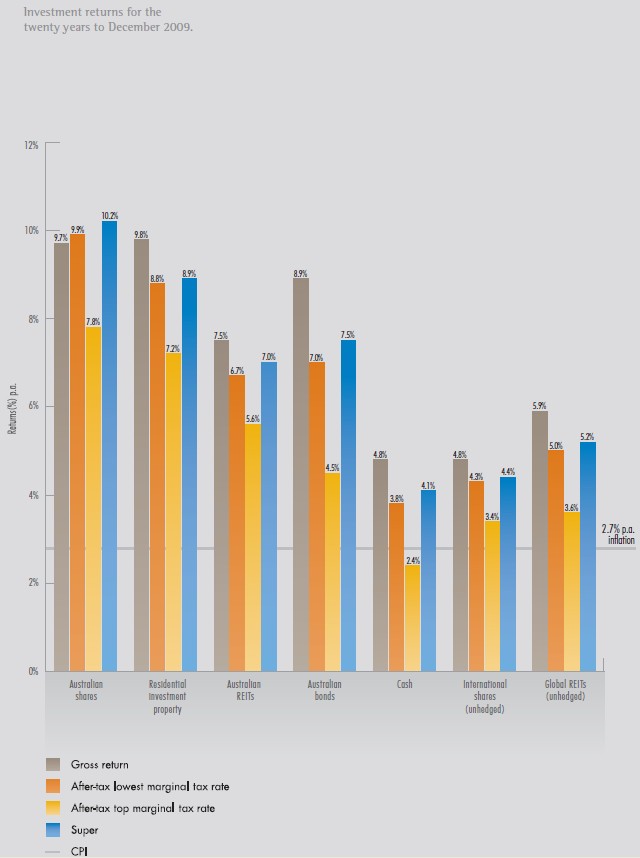
While I am not suggesting that Russell Investments is correct and Mr Yardney is wrong, the verdict about which investment is better over the long haul is unclear.
In any event, direct comparisons between the two asset classes are problematic as they are very different investments. Shares are highly liquid, more volatile, and have low holding/transaction costs, whereas the opposite is true for property.
Further, it is well know in investment circles that past performance is no indication of future profits. Just because Australian home prices have risen solidly in the past in no way means that they will continue to rise unabated in the future.
And whilst leverage works to enhance asset returns during an upswing, it has the opposite effect of amplifying losses when prices stagnate or fall – a risk that Mr Yardney glosses over. One only has to look at housing markets overseas to see that housing values can fall precipitously.
Arguably, the risks from gearing into housing are particularly high at present thanks to the low yields on offer, which are well below mortgage interest rates. Someone purchasing an investment property now would need to achieve solid capital growth just to offset the cash flow losses associated with holding property.
Back to the article.
But don’t get me wrong, while there’s little doubt that property is a potent wealth-builder in the long-term, it does go through the same kinds of cycles as other investment classes, which means that the reported high long-term average returns take into account periods of very high growth and also periods when property went nowhere for a few years….
But look at the property prices that prevailed 10 and 20 years ago and look at property prices today. Property investment is a long-term play – you need to be patient, as values in our major capital cities have doubled every seven to 10 years.
What were the factors behind those cycles?
It’s the old story of supply and demand. Property prices are pushed up by the demand created by a healthy economy, by high levels of employment, population movements caused by migration and immigration and positive market sentiment.
They are dragged down when the economy performs poorly, when interest rates rise, when employment and immigration figures fall, when supply exceeds demand and when the market place is nervous about their wealth and their future.
Cycles are an inevitable part of any investment market and our property markets are behaving normally at present.
Lets look at the real factors behind the so-called doubling of home values every seven to ten years.
First, there was the high inflation of the 1970s and 1980s that pushed-up the prices of everything, from homes to wages and food. When inflation is stripped-out of Australian home values, you find that home prices were actually relatively stable until the late 1980s (see below chart).
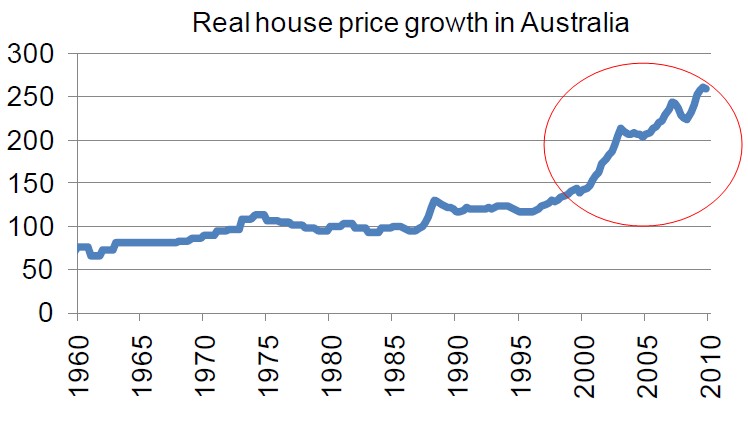
A breakdown of real house price growth by capital city is provided below:
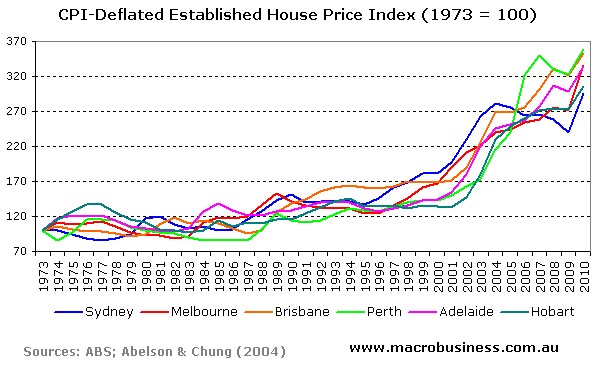
Second, the strong gains in property values since the late 1980s were fuelled by an explosion of mortgage debt:
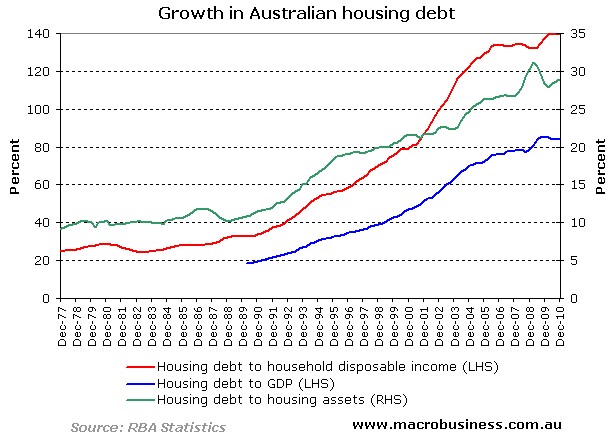
That’s been funded, to a large extent, by heavy offshore borrowings by Australia’s banks:
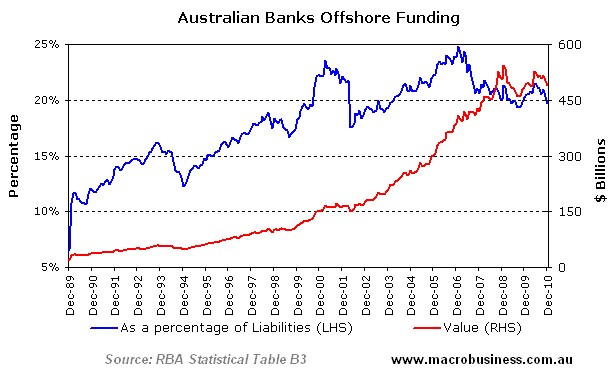
However, it is mathematically impossible for debt levels to continue rising at the rate of the past two decades. And without continual strong growth in mortgage credit, real home values cannot continue their upward march.
As noted by Data Diary yesterday, the recent sharp slowdown of mortgage credit issuance has resulted in the first trend-break in average loan values in 35 years (see below chart). If the slump in home lending continues, it will be difficult for house prices to hold steady, let alone increase.
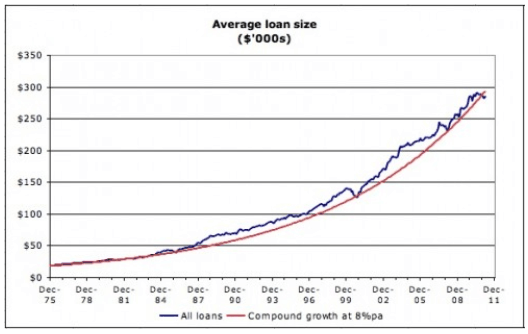
Finally, the rampant buying of homes by the baby boomer generation had, until now, provided heavy tailwinds for home prices. However, with the baby boomers gradually entering retirement from 2011, and needing to free-up cash to fund their lifestyles by liquidating their investment property holdings and downsizing, home prices will face headwinds going forward. A recent study by the Bank for International Settlements (BIS) predicted that the ageing of the baby boomers would reduce Australia’s real house price growth by around 30% over the next 40 years compared to neutral demographics.
Anyway, back to the article.
What’s ahead for property?
Eventually the cycle will move on – it always has. And traditionally the more affluent suburbs tend to perform well at the beginning of the property cycle and that’s what is likely to happen again this time around…
As our economy and the sharemarket picks up, more affluent Australians will be back in the market upgrading their homes with many chasing similar types of property pushing up values in our more “up market” suburbs.
As values increase in these inner ring suburbs, the price differential between these and their neighbouring suburbs will increase. Soon buyers will start looking for ‘bargains” in these adjoining suburbs and the increase in property values will ripple out to the middle ring suburbs.
This increase in property values and higher rents will start to draw investors back into the market. However, many beginning investors will hold back at this early stage of the property cycle, waiting for more signs of certainty.
Of course while they are waiting many will miss out on significant property price growth the savvy investors who get in early and buy counter cyclically will enjoy.
There’s no mention of the significant risks facing the housing market or weighing-up of alternative (safer) investment opportunities (e.g. fixed interest). Even with acknowledgement of cycles, it’s more of the tired old “property only goes up… better buy before you miss out” argument, only worded differently.
Once again, past performance is no indication of future profits.
What about affordability?
Every cycle I hear the cry; “Property prices are too high! They can’t keep going up like that.”
I remember it in the early 80’s and then again in the late 80’s when people said house prices just can’t go up any more. “They are so high our children will never be able to afford a house.”
But prices doubled over the next decade until they again said the same in 2003 as prices rose through the boom that started in 2001.
Of course many are saying the same again now.
It is difficult to deny that homes were far more affordable in the 1980s than now. Australian capital city median multiples (median house prices divided by median household income) were around half what they are today (see below Demographia chart):
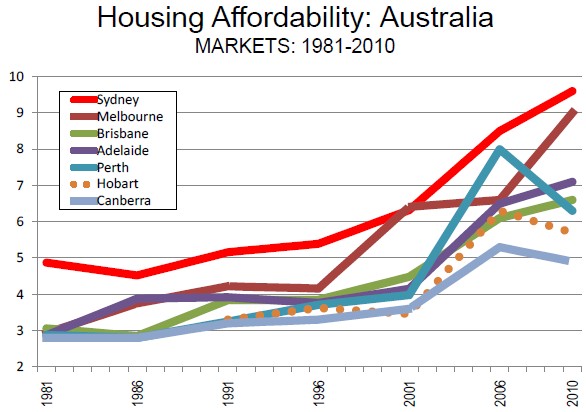
And mortgage interest payments absorbed a far smaller proportion of household income:
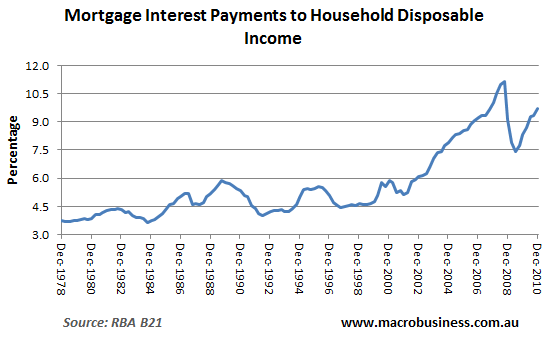
To add insult to injury, the above chart does not include the repayment of higher loan principal. When added alongside mortgage interest, housing affordability now compared to earlier periods is even worse.
Such low levels of affordability will act as a constraint on house price growth going forward.
Back to the article.
However, while most of us are sympathetic to the plight of the average first home buyer struggling to get into their first property, I feel that even if they don’t admit it, secretly most home owners enjoy hearing how house prices keep rising.
Those of us already in the “game” take comfort from the fact that our homes, our castles, are quietly but consistently increasing in value. And deep down we hope this continues because not only does it make us feel wealthier, it actually makes us wealthier.
Mr Yardley really lost me here. The biggest inter-generational transfer of wealth from young to old in history is a “game”, apparently. Let’s ignore the stress caused by higher debt burdens. Or that Australia is now increasingly vulnerable to external shocks because of the huge accumulation of debt, much of which has been borrowed from fickle international capital markets. Or that productive enterprises have been starved of funding because Australia’s banks have channelled the bulk of their lending towards housing. And I might add, if Mr Yardley remains in the game, he is currently getting less wealthy, though I can’t vouch for how that makes him feel.
In summary, our property markets are behaving normally working their way through their individual property cycles… Are you ready to exploit the opportunities that will arise?
Individual property cycles, sure. How about a structural shift towards unwinding the giant credit bubble that Mr Yardley so enthusiastically participated in building.
Cheers Leith

